How Consumers Use Peer-to-Peer Mobile Payment Apps
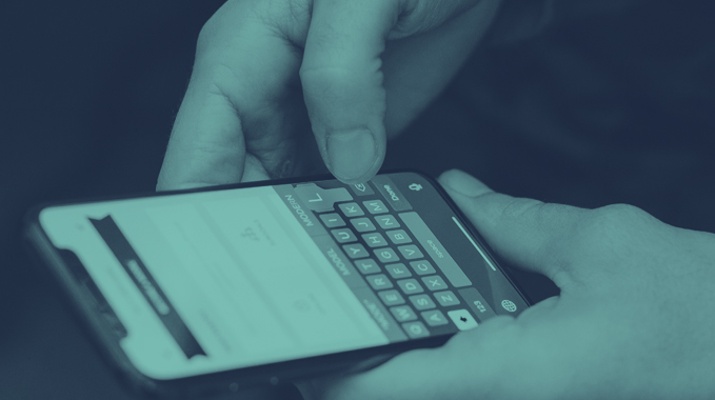
How Consumers Use Peer-to-Peer Mobile Payment Apps
Peer-to-peer (P2P) mobile payment apps are changing how people exchange money. The Manifest surveyed over 500 smartphone owners to analyze the popularity of PayPal and Venmo and to understand how millennials use P2P mobile payment apps differently than older generations.
The New York Times published an article in mid-2017 titled “Thanks to Venmo, We Now All Know How Cheap Our Friends Are.” The article argues that the rise of Venmo – an app that allows you to send any amount of money to someone with the click of a button – has created a generation of selfish penny-pinchers. For example, people will no longer cover a coffee as a kind gesture but will instead expect an exact payment of $1.74 in return.
Although an opinion piece, the article exemplifies the divisive opinions that exist around peer-to-peer payment apps.
Peer-to-peer (P2P) payment apps have experienced a rapid rise in popularity over the past few years. These apps usually connect to individuals’ bank accounts and can be used, for example, to quickly and easily send $5 to a friend to cover your half of lunch.
The apps continue a trend of cashlessness and are impacting how purchases are made – for better or for worse.
The Manifest surveyed more than 500 smartphone owners to better understand how consumers use P2P mobile payments apps, such as PayPal and Venmo.
Businesses can use this data to better understand how mobile payment apps are changing consumers’ purchasing behaviors.
Our Findings
- Nearly half (46%) of smartphone owners regularly use P2P payment apps.
- PayPal is used most (73%) among P2P payment apps, followed by the company’s subsidiary app, Venmo (14%), though confusion over the definition of "peer-to-peer" may influence results.
- Most people prefer their favorite P2P payment app because it offers better security (26%) or most of their peers use it (26%).
- Payment apps are most popular among millennials (51%) but only slightly more so than Gen Xers (48%).
- Millennials use P2P payment apps to pay for food and drinks almost 3x more than older generations, potentially indicating a generational shift in how people split bills.
- Only 15% of respondents who use P2P payment apps have used cryptocurrency to make a payment.
Peer-to-Peer Payment Apps Are Convenient and Flexible
P2P payment apps are popular in the U.S. because they make the exchange of money easy.
Nearly half (46%) of smartphone owners say they regularly use peer-to-peer payment apps.

These apps offer convenience and flexibility when it comes to making payments.
“It’s the ease and simplicity of use,” said Zack Drew, head of business development at Blue Label Labs, an app design, development, and marketing agency. “It’s easier than using a credit card, especially for group purchases.”
As smartphones become more central to our everyday lives, it makes sense that payments would be integrated into the devices we carry with us almost everywhere.
PayPal Reigns, Though Definitions May Be Confused
The survey found PayPal to be the most popular P2P payment app by a wide margin.
Nearly three-fourths of respondents (73%) said they most frequently use PayPal, compared to 14% who use Venmo and 5% who use Apple Pay.
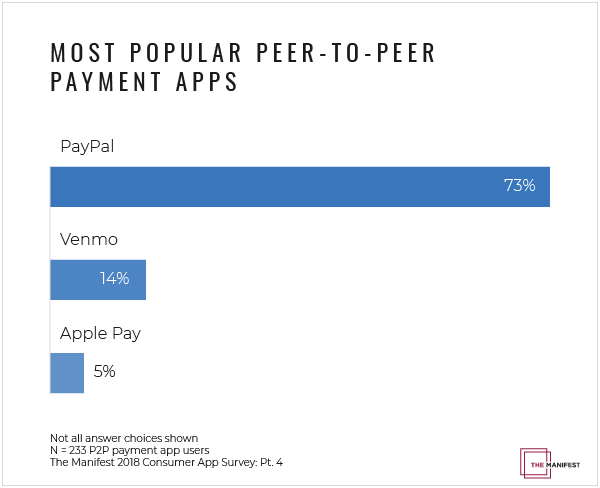
PayPal has existed in some form since 1998. This longevity has lended the company an aura of trust that other mobile payment apps struggle to replicate, even though PayPal only launched its profile-oriented P2P payment service in late 2015.
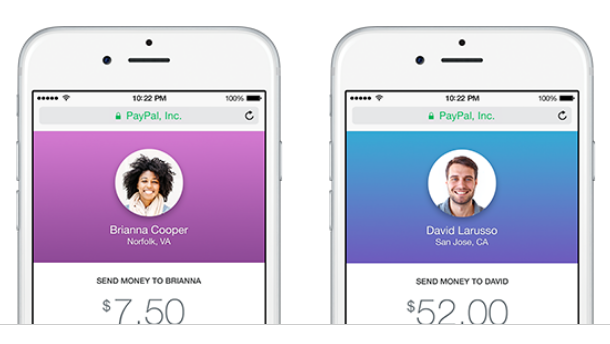
Thus, PayPal is often synonymous with security in the world of online transactions. It then makes sense that the largest percentage of respondents said they use their favorite P2P payment app the most because they believe it offers better security, tied with peer usage.
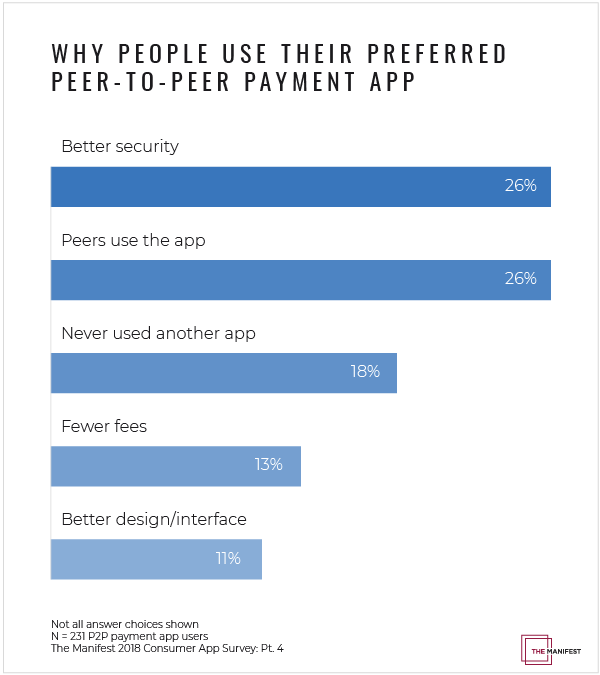
P2P payment apps face more scrutiny than many other categories of apps, given the financial information disclosed on the apps.
“PayPal is a big name, has been in the market a long time, so people trust it with their money,” said Sudeep Srivastava, co-founder and CEO at Appinventiv, a mobile app design and development company.
PayPal’s ranking in the survey, however, may be due to its popularity for online business transactions, as opposed to P2P payments specifically, Drew argued.
“You can use PayPal to pay for things all over the internet or at businesses,” Drew said. “I wouldn’t consider all that peer-to-peer. I don’t know anybody who uses PayPal peer-to-peer like that.”
Although PayPal is well-known as the method businesses use to send and receive money online, not as many consumers are likely using the app to simply send a few dollars to their friends.
PayPal also owns the survey’s runner-up, the rapidly growing Venmo – which is primarily known for its peer-to-peer functionality.
Venmo processed $12 billion in payments in Q1 2018, an 80% increase from Q1 2017.
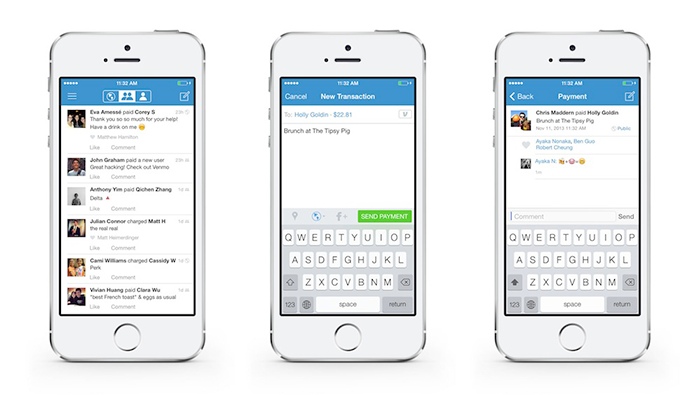
Thus, PayPal controls a significant portion of the P2P payment app market regardless of whether consumers are using the PayPal or Venmo apps.
Millennials Use Peer-to-Peer Payment Apps Most
Not surprisingly, younger smartphone owners use P2P mobile payment apps the most.
Over half (51%) of millennials, 18 to 34 years old, regularly use P2P payment apps, but Gen Xers, 35 to 54 years old, (48%) are only slightly behind.

It makes sense that millennials would use the apps most, given their greater comfort with technology. However, millennials also use the apps differently than older generations.
Millennials say they typically use P2P payment apps to pay for food or drinks nearly 3x more than older generations.

Nearly 30% of millennials use P2P payment apps to pay for food and drinks, compared to 10% of older generations.
Older generations, meanwhile, use the apps to pay for physical objects, such as clothing and furniture; 40% frequently use P2P payment apps to pay for these items, compared to 27% of millennials.
The data potentially indicates that millennials integrate these apps more commonly into their everyday lives. Food and drinks are purchased much more frequently than physical objects.
“Just Venmo me” is a common millennial expression heard at restaurants after a large group meal, when it’s easier to give one credit card with the check and figure out the money owed later.
“I think the whole concept of cash on hand is not as much a concept for millennials,” said Chris Hobbs, president of Two Tall Totems, a Vancouver-based mobile app and software development firm. “I think electronic payments are even easier because now you don’t even have to go to an [ATM]. You can send money sitting right there.”
These apps potentially encourage pettiness, as the New York Times article mentioned above argues – users of P2P payment apps may expect any money owed to be paid back in full, indicating a decrease in generosity.
However, the apps could also be evening the playing field, especially for cash-strapped millennials facing large amounts of debt and rising housing costs.
“For some people in lower-earning jobs, a $5 difference in price actually does matter,” concedes one Quartz article describing Venmo’s effect on behavior.
Whether you find the behaviors surrounding P2P payment apps stingy or efficient, it’s true that the apps are changing how people make payments and the immediacy that consumers expect money.
Cryptocurrency Peer-to-Peer Payments Still Minor
Despite the oversaturation of headlines on cryptocurrency, the digital currency has not yet gained traction in terms of peer-to-peer payments.
Only 15% of respondents say they have used cryptocurrency to make a P2P payment.

Cryptocurrency has the ability to revolutionize P2P payments. It’s anonymous, fast, and doesn’t require a bank account. Yet, many see cryptocurrency as a fad, saying that the “bubble” will burst soon. Cryptocurrency saw record-high prices in late 2017 but has since rapidly lost much of its value.
“We are in a bubble where people are doing a lot of things that don’t make any rational sense outside of the bubble mentality,” Wikipedia founder Jimmy Wales recently said.
Yet the P2P payment app Square recently added the cryptocurrency Bitcoin to its platform.

Despite all the talk of cryptocurrency bubbles, the other side argues that rapidly changing demands are simply part of a larger game that is still worth investing in.
Given cryptocurrency’s inherently digital nature, it may become a more common method for P2P payments in the future.
Peer-to-Peer Payment Apps Are Changing Consumer Purchasing Power
P2P mobile payment apps are changing one of the most basic of tasks – the exchange of money among peers.
Nearly half (46%) of smartphone owners use these apps. PayPal reigns as the top brand, but its subsidiary brand, Venmo, is gaining popularity.
Millennials use the apps the most but only slightly more than Gen Xers. Millennials, however, use P2P payment apps to pay for food and drinks far more often.
How we pay each other has changed dramatically over the centuries, from bartering to cash to credit cards. Peer-to-peer payment apps are leading a transition that is both familiar and new.
About the Survey
The survey includes responses from 511 smartphone owners who use at least three different apps daily.
The respondents were primarily female (72%). Age was split among respondents: 18 to 24 years old (15%), 25 to 34 (28%), 35 to 44 (21%), 45 to 54 (18%), 55 to 64 (12%), and 65 and over (5%)
